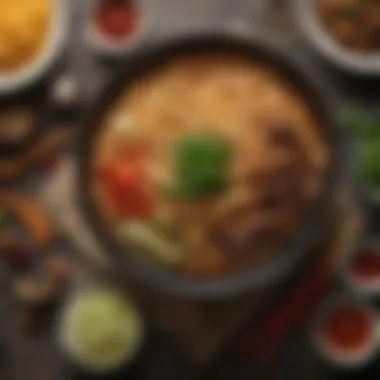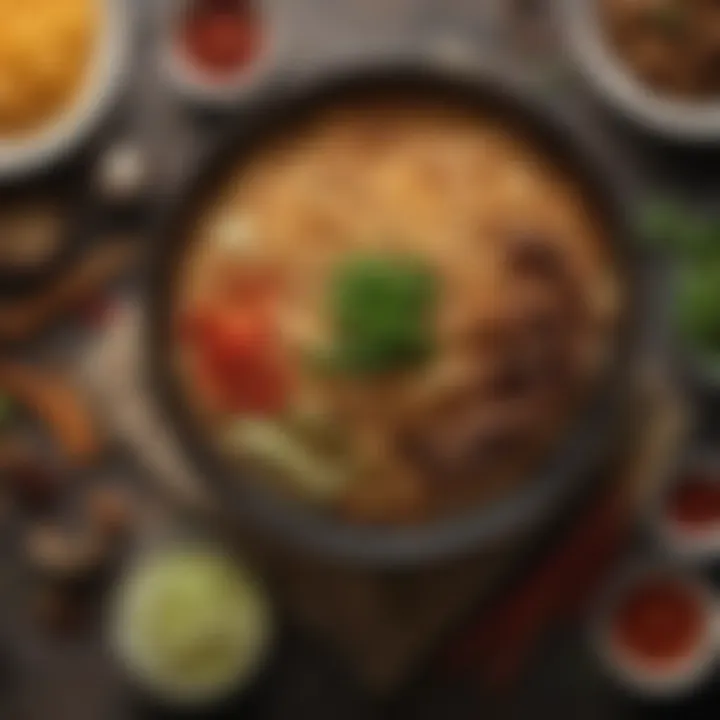Asian Takeout: A Comprehensive Exploration


Intro
Asian takeout is more than just a convenient meal option; it is a rich tapestry of culinary heritage and modern adaptation. With roots deeply embedded in various regions across Asia, this cuisine has evolved significantly. The article aims to provide a comprehensive analysis of Asian takeout, examining everything from its historical context to the modern food delivery systems that serve it.
In the following sections, we will explore popular dishes, regional variations, and incorporate health considerations, giving you valuable insights into this vibrant dining trend. With societal changes influencing the way we consume food, the importance of understanding these aspects cannot be overstated. Not only will this enhance appreciation for Asian takeout, but it will also inspire culinary creativity at home.
"Asian takeout represents a blend of traditional roots and modern adaptations, reflecting the evolving dining culture."
By the end of this exploration, readers will have a clearer picture of how Asian takeout fits into contemporary diets and how these culinary practices are influencing eating habits around the world. Let us dive into the heart of Asian takeout, starting with its diverse recipes.
Understanding Asian Takeout
The concept of Asian takeout encapsulates numerous elements that reflect the rich heritage and culinary diversity of Asia. In this article, we will explore not only the typical dishes but also the cultural significance of takeout in various Asian regions. Understanding Asian takeout allows us to appreciate the convergence of tradition and modernity in a dish. It also highlights how these meals have evolved, adapting to the fast-paced lifestyle of today’s society.
In the context of global dining, Asian takeout serves as a gateway to explore authentic flavors and techniques from different cultures. One benefit of this exploration is the opportunity to understand the nuances of Asian cuisines. As food lovers, it broadens our palate and enriches our dining experiences.
However, there are also considerations to keep in mind about takeout. The balance between convenience and health, for instance, is vital. With many people leading busy lives, the quick availability of meals is appealing. Still, recognizing the nutritional content and sourcing practices of ingredients contributes to conscious eating. By diving deep into these aspects, we can cultivate a better understanding and appreciation of Asian takeout.
Historical Context of Asian Cuisine
Asian cuisine has deep historical roots shaped by various cultural, geographical, and social influences. The origins can be traced back thousands of years when ancient communities began to refine their cooking techniques. Trade routes, such as the Silk Road, significantly impacted culinary exchanges across regions. Spices, herbs, and cooking methods spread, influencing local practices.
Different countries developed distinct culinary identities based on available resources and cultural practices. For instance, rice became a staple in many Asian countries, such as China and Japan, while wheat-based products are more prevalent in parts of Central Asia. Over time, these factors coalesced to form a prismatic view of what we consider Asian cuisine today.
As Asian immigrants settled in various parts of the world, they adapted their traditional recipes to local ingredients and tastes. This evolution contributed to the takeout culture, where dishes were conveniently packaged and suited for consumption away from home. Today, the blend of authentic and westernized flavors in Asian takeout highlights the dynamic nature of these culinary traditions.
Defining Takeout Culture
The rise of takeout culture is a remarkable phenomenon, particularly in urban settings. It signifies a departure from traditional dining experiences. Takeout allows people to enjoy their cherished meals without the constraints of time and space. As cities grow and lifestyles become busier, the appeal of takeout continues to surge.
Takeout culture is characterized by its accessibility and variety. Asian takeout offers a wide range of options, from Chinese fried rice to Japanese sushi. This breadth of choices caters to diverse palates and dietary preferences, making it a favorite among different demographics.
Moreover, technology has played a pivotal role in transforming takeout. The emergence of food delivery apps has revolutionized how consumers access their meals. People can now order dishes from various restaurants at their convenience. This evolution reflects the changing consumer behaviors and expectations surrounding dining.
The continuous adaptation of Asian dishes in takeout menus highlights the intersection of convenience and tradition, marking a significant shift in food culture.
Regions of Focus
Understanding the diverse regions of Asia is crucial when exploring Asian takeout cuisine. Each region carries a unique culinary heritage that influences its dishes, flavors, and preparations. Appreciating these regional distinctions promotes a deeper appreciation of the variety available in Asian takeout. As many people discover new tastes or revisit beloved classics, knowing the origins and specialties of various Asian cultures enriches the dining experience.
Chinese Takeout Essentials
Chinese takeout has become a staple for many households. Dishes such as General Tso's chicken, sweet and sour pork, and fried rice often dominate menus. The beauty of Chinese takeout lies in its balance of flavors, textures, and colors. Ingredients like soy sauce, ginger, and garlic contribute to savory profiles that are both satisfying and comforting.
The cooking techniques used in Chinese cuisine significantly impact the taste of takeout dishes. Stir-frying, steaming, and braising lead to quick cooking with maximum flavor retention. Additionally, the traditional concept of yin and yang plays a role, where each dish aims for a balance between flavors and health. This emphasis on harmony makes Chinese takeout not only enjoyable but also a bit nutritious.
Japanese Takeout Specialties
Japanese takeout showcases an elegant simplicity that contrasts sharply with other Asian cuisines. Items like sushi, sashimi, and bento boxes emphasize freshness and quality. Sushi rolls, such as California rolls or spicy tuna rolls, have gained immense popularity outside Japan, offering a fusion of flavors. Japanese cuisine often features rice, seafood, and seasonal vegetables, which help create varied and visually pleasing dishes.


The adherence to tradition and aesthetics in Japanese cooking speaks volumes to its cultural importance. Japanese takeout provides a convenient way for people to experience this artistry away from home. Moreover, the growing interest in health has led many to appreciate Japanese cuisine's focus on clean flavors and fresh ingredients.
Thai Cuisine Offerings
Thai takeout is characterized by the boldness and complexity of its flavors. Dishes like pad thai and green curry exemplify the balance of sweet, sour, salty, and spicy. Ingredients such as fish sauce, coconut milk, and fresh herbs create exciting profiles that awaken the palate. Each region in Thailand has its specialties; for example, southern dishes are typically spicier, while northern offerings often include more herbal elements.
For diners unfamiliar with Thai cuisine, it can be an adventure. The combination of textures and tastes makes Thai takeout appealing to many. Additionally, the global popularity of Thai cuisine has led to the widespread availability of numerous varieties, catering to those seeking both authenticity and adaptation.
Korean Takeout Trends
Korean takeout has gained momentum as its flavors become more mainstream. Dishes like bibimbap and Korean fried chicken have become favorites among many. The vibrant use of vegetables, fermented foods, and spicy sauces makes Korean cuisine a healthy choice. Kimchi, a staple in Korean food, offers probiotic benefits, enhancing their appeal from a health standpoint.
This surge in popularity can be attributed to a mix of cultural phenomena, including K-dramas and K-pop, which have elevated interest in Korean lifestyles and foods. The communal aspect of dining in Korean culture, often involving shared dishes, influences how takeout is consumed. This trend resonates well with the modern dining experience, where socializing over food remains a central theme.
Vietnamese Street Food Influence
Vietnamese takeout draws representatives from street food culture, emphasizing affordability and freshness. Popular items such as pho and banh mi encapsulate this. Pho, a fragrant noodle soup, is both hearty and flavorful, showcasing herbs, spices, and clear broth. Banh mi, a Vietnamese sandwich, melds French influences with local flavors, using crusty baguettes and a variety of fillings.
The focus on fresh ingredients and herbs positions Vietnamese cuisine as a lighter alternative, which appeals to health-conscious individuals. Many people appreciate the versatility found in Vietnamese takeout, suitable for different tastes and dietary needs. As street food elements inspire more restaurants, this culinary tradition shines bright in the takeout scene.
Popular Dishes
The category of popular dishes within Asian takeout is crucial as it encapsulates the very essence of what makes this cuisine adored worldwide. Each dish not only represents a unique style of cooking but also demonstrates regional tastes and cultural influences. By exploring these dishes, one can appreciate the diverse flavors and techniques that characterize Asian culinary practices. Moreover, understanding popular dishes aids consumers in making informed choices, allowing for a more enjoyable takeout experience.
Stir-Fries
Stir-fries are iconic in Asian takeout, known for their quick preparation and vibrant flavors. They typically consist of various vegetables, meats, and sauces, cooked rapidly over high heat. This method retains nutrients while enhancing the dish's freshness. Common examples include chicken with broccoli or beef with bell peppers. The balance of sweet and savory flavors, alongside the textural contrast, makes stir-fries a favorite choice for many.
Noodles and Rice Bowls
Noodles and rice bowls represent staples in numerous Asian cultures, making them essential in takeout menus. Dishes like Pad Thai or ramen showcase regional ingredients and tradition. Beyond flavor, these dishes offer versatility. They can be easily customized with proteins or vegetables, catering to diverse dietary preferences. Noodles and rice provide a satisfying base for various toppings, resulting in hearty meals that are enjoyed year-round.
Dim Sum and Small Plates
Dim sum and small plates are not just appetizers; they provide a culinary experience. These dishes invite sharing, which promotes social interaction during meals. Each small plate offers a glimpse into a wider culinary tradition, often highlighted by dumplings and buns. The variety encourages diners to explore different flavors and textures at once, making it a popular option for groups. This shared dining approach elevates the celebration aspect of meals in many Asian cultures.
Curry Varieties
Curry is a prominent element in various Asian cuisines. Each country's interpretation has distinct flavors and spices. For instance, Thai curries often feature coconut milk, while Indian curries utilize a range of spices and cooking techniques. Customers benefit from the rich and diverse flavor profiles of curries, making them comforting and hearty options. The wide selection signals the intricate relationships of culture, climate, and ingredients, playing a vital role in the global Asian takeout scene.
Sushi and Sashimi
Sushi and sashimi have gained immense popularity beyond traditional Japanese restaurants. Sushi combines rice, fish, and other ingredients in artful presentations, while sashimi showcases the freshness of fish without additional ingredients. These dishes emphasize quality and simplicity, appealing to many health-conscious consumers. The chance to enjoy these items conveniently allows for an elevated dining experience, often sought after in takeout formats.
"Asian takeout is not just about quick meals; it is about celebrating diverse culinary practices and flavors."
In summary, popular dishes in Asian takeout offer more than mere sustenance. They reflect rich histories and cultural expressions, making them significant in understanding this cuisine. Consumers benefit from exploring these dishes in terms of variety, nutrition, and cultural appreciation.
Ingredient Insights
Understanding the ingredients used in Asian takeout is crucial for grasping the overall essence and flavor profiles of the cuisine. These ingredients not only inspire a unique palette of tastes but also carry significant cultural and nutritional values. The diversity in Asian cuisine is reflected in its rich variety of components, from staple items to aromatic herbs and spices. Knowing what goes into these dishes enriches the dining experience and encourages more informed food choices.


Common Asian Ingredients
Asian cuisine employs a wide range of ingredients, many of which are foundational to its most beloved dishes. Here are some commonly used items:
- Soy Sauce: A fundamental seasoning made from fermented soybeans, soy sauce adds umami flavor to many dishes, including stir-fries and marinades.
- Rice: This staple is a common accompaniment in many Asian meals. Varieties like jasmine, basmati, and sticky rice each have distinct textures and flavors.
- Noodles: From the thin rice noodles of pho to the thicker udon, noodles serve as a base for various dishes.
- Tofu: A versatile protein source that absorbs flavor well, tofu is widely used in vegetarian and vegan options.
- Ginger and Garlic: Essential aromatics in Asian cooking, both ginger and garlic provide depth and warmth to dishes.
- Chilies: Used in various forms, from fresh to dried or as paste, chilies contribute heat and complexity.
This list only scratches the surface of the myriad ingredients present. Each one plays a unique role in enhancing flavor and texture.
Health Benefits of Asian Ingredients
Many Asian ingredients possess health benefits that contribute to a balanced diet. For instance:
- Ginger: Known for its anti-inflammatory properties, ginger can help in digestion and boost immunity.
- Garlic: Rich in antioxidants, garlic is thought to lower blood pressure and improve cholesterol levels.
- Turmeric: Often used in Indian cuisine, this spice contains curcumin, which has significant anti-inflammatory and antioxidant properties.
Additionally, many Asian dishes are rich in vegetables and lean proteins, further promoting a nutritious diet. The emphasis on fresh herbs and vegetables helps create meals that are both satisfying and good for health.
Sourcing Authentic Ingredients
For cooking authentic Asian dishes, sourcing high-quality ingredients is important. Here are some tips for finding the best ingredients:
- Visit Asian Markets: Local Asian grocery stores often carry authentic products not found in mainstream supermarkets. Look for brands that are well-known in their respective regions.
- Online Retailers: Websites like Amazon or specialty food retailers can be good sources for hard-to-find items.
- Community Recommendations: Engaging with local culinary communities can lead to valuable insights about where to buy authentic ingredients.
By paying attention to sourcing, one can significantly enhance the quality of home-cooked Asian meals. Understanding the role of these ingredients, both nutritionally and culturally, creates a complete picture of Asian takeout that goes beyond mere consumption.
Health Considerations
Understanding health considerations in Asian takeout is essential for consumers who wish to balance taste with nutritional value. Many Asian dishes are celebrated for their flavors but can be high in sodium, sugars, and unhealthy fats. Recognizing these elements is crucial for making informed choices, especially when incorporating takeout into a regular diet.
Nutritional Profiles of Popular Dishes
Various Asian takeout favorites offer an array of nutritional benefits but also present specific challenges. For instance, a typical serving of chicken teriyaki might be high in sugar due to the sauce, yet it provides protein. On the other hand, pad Thai is rich in carbohydrates and can be a source of protein if made with shrimp or chicken. However, the inclusion of peanuts can add healthy fats but also elevate calorie counts.
Key nutritional profiles include:
- Rice Dishes: Often a staple, rice can be either white or brown. Brown rice offers more fiber and can aid in digestion.
- Stir-Fries: Generally contain a variety of colorful vegetables, enhancing vitamin intake. The type of oil used for cooking can affect the overall healthiness of the dish.
- Curries: Rich in spices which may provide health benefits, however, creamy bases can increase the calorie content significantly.
Particular attention should be given to the serving sizes; larger portions can quickly turn a healthy dish into an unbalanced meal.
Balancing Takeout with Healthy Eating
To enjoy Asian takeout without compromising health, consider these practical tips for balance:
- Choose Wisely: Opt for boiled, steamed, or grilled options rather than fried or heavily sauced dishes. Dishes like miso soup or sushi rolls can often be healthier choices.
- Share Plates: If dining with others, sharing multiple dishes allows for a varied meal that can mitigate the intake of higher-calorie items.
- Increase Veggies: Request extra vegetables in stir-fries or as sides. This adds nutrients while reducing the overall calorie density.
- Mind the Rice: Limit the amount of rice to control carbohydrate intake. A smaller portion can make a significant difference in total calories.
- Beverage Choices: Avoid sugary drinks. Opt for water or tea; these choices complement meals without adding unwanted calories.
Cultural Impact
The cultural impact of Asian takeout extends beyond mere convenience and flavor. This section examines how Asian takeout has influenced culinary trends, societal interactions, and overall dining experiences across different regions.
Asian takeout serves as a lens through which we can observe the intersections of globalization and local food cultures. When one thinks of chicken teriyaki or spicy curry, these dishes are not merely meals; they are symbols of cultural exchange. The introduction of these foods into Western diets is a testament to the increasing cultural diversity in our eating habits.
Fusion Cuisine Trends


Fusion cuisine has emerged as an exciting phenomenon, blending traditional Asian flavors with Western culinary techniques. Dishes like Korean tacos and sushi burritos exemplify this trend. These creations are more than just food—they represent a willingness to embrace and adapt cultural elements. They allow innovators in the food space to experiment and create combinations that appeal to a wide audience.
- Korean Tacos: Originating from food trucks in Los Angeles, these tacos use Korean bulgogi as a filling, wrapped in a traditional tortilla.
- Sushi Burritos: Combining the burrito’s portability with sushi's freshness, this dish encapsulates both cultures in one meal.
- Thai Pizza: Infusing elements like peanut sauce and fresh herbs into the classic Italian dish shows the fluidity of culinary boundaries.
Fusion cuisine trends like these highlight the adaptability of ingredients and cooking styles, inviting diners to broaden their palates and explore culinary boundaries.
Asian Takeout in Global Context
Asian takeout is not just about individual dishes; it occupies significant space in the global culinary context. The proliferation of Asian takeout restaurants worldwide demonstrates its universal appeal. Many cities offer multiple options for Asian cuisines, making it easier for people to find their favorite dishes no matter where they are.
This global presence has economic implications as well. Asian takeout contributes to the economic vitality of local communities through job creation and local sourcing of ingredients. Moreover, it influences social interactions—meals are shared experiences, and takeout allows families and friends to convey care and connection, even in a fast-paced world.
"The growing Asian takeout industry serves not only as a remedy for hunger but also as a cultural bridge, connecting diverse populations through food."
In essence, the cultural impact of Asian takeout resonates throughout society, shaping culinary landscapes, fostering new eating habits, and enriching community interactions. This phenomenon exemplifies how food can transcend cultural boundaries, leading to a shared appreciation of diverse culinary heritages.
Digital Evolution of Takeout
The digital evolution of takeout signifies more than just a shift in ordering methods; it encapsulates a fundamental change in how consumers interact with food services. In recent years, the proliferation of technology has reshaped the culinary landscape. Restaurants and food delivery services have been forced to adapt to new consumer expectations driven by convenience, speed, and accessibility. As people increasingly turn to their smartphones for meal solutions, understanding this transformation becomes essential for appreciating the current takeout culture.
Digital platforms have become the backbone of the Asian takeout industry. Online ordering systems enable customers to access diverse culinary options at their fingertips. This ease of access transforms how diners explore and experience Asian cuisine. With websites and apps tailored for food delivery, consumers can now view menus, read reviews, and place orders without leaving their homes. This shift not only enhances the convenience factor but also encourages experimentation with dishes previously untried.
The rise of digital takeout presents clear benefits. For one, it fosters competition among restaurants. Establishments must prioritize quality, speed, and customer service to thrive in the current market. Moreover, it provides businesses with valuable data on consumer preferences and behavior. This information can be used to tailor menus and marketing strategies effectively.
However, there are considerations regarding the digital evolution of takeout. It raises questions about food quality, as the time taken in delivery can impact freshness. Additionally, the reliance on technology can alienate those who prefer traditional dining experiences, creating a divide in consumer expectations and norms.
"The digital transformation of the food industry is not just a trend; it reflects shifting cultural values around convenience and access to culinary diversity."
Emergence of Food Delivery Apps
Food delivery apps like Uber Eats, Grubhub, and DoorDash have become prominent players in the Asian takeout scene. These platforms not only facilitate ordering but also serve as marketing tools for restaurants. The convenience of browsing multiple menus in one place allows consumers to discover new and unique dishes. Furthermore, they provide a reality where restaurants can reach wider audiences without needing a physical presence in every neighborhood.
Many delivery apps also offer features like user reviews, images of dishes, and customizable order options, enhancing the user experience. These aspects are particularly crucial in the Asian takeout realm, where visual appeal is often key to enticing customers.
Restaurants embracing this model have reported increased sales and visibility in a competitive market. In doing so, they also leverage technology to streamline operations—automating tasks like order processing and payment collection. However, there is a heavy reliance on these platforms, which sometimes leads to conflicts over fees and commissions.
Changing Consumer Behaviors
Consumer behavior has shifted dramatically in the wake of digital advancements. The once traditional approach of dining-in is now often replaced by a preference for takeout and delivery. Research indicates a growing inclination toward home dining experiences, driven by both convenience and the increased availability of varied authentic Asian cuisines.
Another noteworthy change is the impact of social media on dining habits. Platforms like Instagram and Facebook have created a culture where users share their culinary experiences, prompting others to seek out trendy or visually appealing dishes. This phenomenon leads to heightened demand for certain items, influencing menus and promotions.
Additionally, many consumers now prioritize food quality and sustainability, seeking out options that are not only delicious but also ethically sourced. This trend encourages restaurants to adapt their offerings and marketing strategies.
The End
The conclusion serves as a pivotal component of this exploration into Asian takeout. It synthesizes the various aspects covered in the article and highlights the broad significance of Asian takeout cuisine in today’s dining culture. Understanding the key trends, popular dishes, and cultural impacts is crucial for both enthusiasts and casual diners alike. Thus, the conclusion emphasizes the reflective nature of the culinary journey explored.
Future Trends in Asian Takeout
As the landscape of dining evolves, Asian takeout continues to adapt, embracing new trends and consumer preferences. Here are some significant future trends that will shape Asian takeout:
- Increased Plant-Based Options: With growing awareness of health and sustainability, many restaurants are introducing more plant-based dishes inspired by traditional recipes. Meat alternatives are being integrated into beloved dishes, providing healthier choices.
- Focus on Authenticity: Consumers are showing a preference for genuine flavors and cooking methods over generic takeout options. This includes sourcing authentic ingredients and providing dishes that remain true to their cultural origins.
- Technology Integration: Advancements in technology will likely revolutionize how takeout food is prepared and delivered. Restaurants may adopt AI and machine learning to personalize orders and enhance user experience.
- Sustainable Practices: Environmental concerns are prompting many restaurants to adopt eco-friendly practices, such as using biodegradable packaging and reducing food waste. Greater attention to sourcing ethically produced ingredients is also becoming a priority.
- Health-Conscious Menus: As people become more health-aware, many takeout establishments are revising their menus to highlight lower-calorie options and dishes rich in nutrients. This ensures diners can enjoy flavorful meals without compromising their health goals.
"The evolution of Asian takeout mirrors culinary trends and consumer demands, serving as a vibrant reflection of wider changes in society."
In summary, the future of Asian takeout looks promising, shaped by conscious consumer choices and technological developments. As this sector evolves, it remains an integral part of modern dining culture, continuously redefining our culinary experiences.







